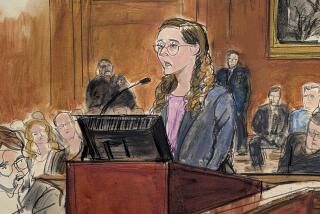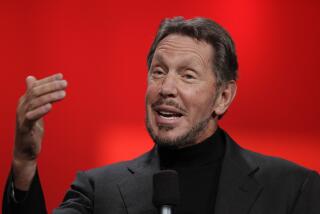Ellison’s Style May Be a Factor in Tech Industry Consolidation
In pursuing his hostile bid to take over PeopleSoft Inc., Oracle Corp. Chief Executive Larry Ellison isn’t just fighting to preserve his company’s position in the business software market. The man widely considered Silicon Valley’s most bombastic executive is pursuing a plan to remake the technology industry itself.
The database software giant’s $6.3-billion offer for PeopleSoft has intensified a debate about Ellison’s larger vision, which is that the software industry is embarking on a massive consolidation that would leave it in the hands of a few huge companies. He wants to make sure Oracle is one of them.
Many Silicon Valley executives and venture capitalists agree that the technology universe is shrinking, and they give the 58-year-old Ellison credit for seizing the moment.
The question that intrigues them is whether he’s the right captain to lead one of the high-tech behemoths that remains.
“He’s an ambitious, aggressive, smart businessperson,” said Randy Komisar, a consulting professor at Stanford University and veteran high-tech entrepreneur who thinks the often outrageous Ellison may be up to the job. “If he were in entertainment, people wouldn’t think twice about it. But in the rather staid technology industry, people like Larry stand out.”
Ellison’s hard-charging pursuit of PeopleSoft shows off the ruthless drive that has made him an admired and ridiculed Silicon Valley archetype, a neck-breaking body-surfer and competitive sailor of comic-book proportions. He isn’t known for following conventions in the business world, or anywhere else. And he isn’t shy about trying to show who’s boss.
Consider what happened when he invited his nemesis, Microsoft Corp. founder Bill Gates, for a visit.
It was 1988, when both Oracle and Microsoft were on the rise. Microsoft had sold its first shares to the public two years before, one day after Oracle. The operating system kingpin was bigger, and Gates was richer, the obvious leader in the personal race Ellison wanted to win more than any other.
Ellison wanted to discuss licensing Oracle’s technology to Microsoft, then-Oracle Senior Vice President Pete Tierney recalled last week. Not wanting to distract his employees with the sight of Gates walking into Oracle’s sleek Redwood City, Calif., lobby, Ellison arranged for Gates to come to his mansion in nearby Atherton, a Japanese-style extravagance with waterfalls and white oak floors.
Tierney and Oracle co-founder Ed Oates escorted Gates from the airport to Ellison’s driveway gate, then pressed the buzzer. More than half an hour passed without Ellison responding, as Gates quietly seethed in the car, Tierney said. When Ellison finally let Gates in, their chat lasted perhaps five minutes, unsurprisingly producing no deal.
“There’s only one way Larry wants to do something,” said Igor Sill, an early Oracle investor and longtime executive recruiter, “and it’s Larry’s way.”
Oracle said Ellison wasn’t available for an interview.
Oracle already dominates the market for software that houses vast amounts of business data and allows for easy access to it. Oracle earned $2.3 billion last fiscal year on sales of $9.5 billion. But its progress in related markets for business applications programs has been slower.
Last week, Oracle raised its initial low-ball tender offer for PeopleSoft shares, convincing many skeptics that Ellison is serious about acquiring the leading maker of programs for payroll and other personnel functions. The PeopleSoft board rebuffed the sweetened offer Friday as too little.
When he launched his bid, first offering a paltry 6% premium for PeopleSoft shares, Ellison’s track record made it easy for many bystanders to believe that his true goal was merely to disrupt PeopleSoft’s planned acquisition of software maker J.D. Edwards & Co. PeopleSoft CEO Craig Conway likened Ellison to Genghis Khan.
Divisions in the Industry
For some, that reputation raises serious doubts about Ellison’s ability to take on a leading role in the industry’s consolidation. PeopleSoft, Siebel Systems Inc. and other companies that logically would come under an expanded Oracle umbrella are now led by former Oracle executives, many of whom Ellison has privately or publicly ridiculed.
“They all despise each other,” which is hardly a useful place to start building industrywide alliances, said Stuart Feigin, one of Oracle’s first programmers and an on-and-off employee from 1978 to 1998. Under such a demanding CEO, “it’s hard to imagine even one company working as a big, happy family -- let alone many companies.”
Ellison is often faulted for driving away talented and respected heirs apparent, including PeopleSoft’s Conway and turnaround architect and former President Ray Lane, now a general partner at the venture capital firm Kleiner Perkins Caufield & Byers.
The lack of a clear successor at Oracle is a recurring concern for some investors, especially when they read about Ellison’s penchant for flying fighter jets, sailing through severe storms in the America’s Cup race or breaking two bones in his neck and nearly killing himself in the Hawaii surf, as he did in 1991.
Yet for all his colorful clashes with insiders and others, there is a significant and arguably growing advantage to having someone with Ellison’s attributes in charge of a broader software movement, Feigin and others say.
Because he is almost demonically possessed by the need to win at all costs, they say, Ellison is a good bet to do what it takes to build a company that will survive and conquer. And he has proved himself more adaptable than many of his CEO peers, with the ability to learn from his mistakes and change direction.
More a master marketer than a technical genius, Ellison encouraged an aggressive sales culture through the late 1980s that included booking revenue after quarters had ended and on deals where customers secretly had the right to return their goods. The Securities and Exchange Commission sued the company in 1993 over the earlier problems, winning a fine and a promise not to violate laws in the future.
“Larry was embarrassed. I and others came in and helped him clean the place up,” said Oracle Chief Financial Officer Jeff Henley. “He certainly learned a lot about financial controls and management. He’s definitely grown and evolved.”
More recently, Oracle has turned around relations with angry users who complained about new pricing schemes, buggy software and Oracle’s long habit of selling software first and then writing it later.
“They have a much more noticeable customer focus,” said Yale University information technology buyer Arthur Hunt, who serves as president of the independent 2,000-member Oracle Applications Users Group. “To me, it’s night and day.”
Willing to Take Chances
Oracle’s biggest successes are due to Ellison’s willingness to take his chances going his own way. In addition to making the early calls that established Oracle as a powerhouse -- most notably designing a database that would run on a variety of computer operating systems -- Ellison was ahead of the pack in selling overseas, in setting variable pricing based on the computer systems used by customers and in shifting to an architecture better suited to the Internet.
The risk-taking tendency extends to Ellison’s private endeavors, including the billionaire’s 5-year-old medical foundation devoted to basic research on aging and infectious diseases.
“The foundation reflects much of Ellison’s style,” said Richard Sprott, executive director of the Ellison Foundation in Bethesda, Md. “It takes chances on high-risk, high-reward projects that many other funding groups steer clear of.”
As competitive outside of the industry as he is within it, Ellison has collected and discarded skilled skippers the way he has top executives. He picked one of the country’s top-ranked sailors to lead the Maxi-class 78-foot racing yacht Sayonara in 1995, then dropped him a year later.
“He’s bold and daring, but I don’t have anything good to say about his team-building ability, management style or leadership skills,” said Paul Cayard, who has sailed in every America’s Cup since 1983.
When Ellison doesn’t have the authority to fire, he can always sue, as the city of San Jose learned. Ellison’s $38-million Gulfstream V executive jet often violated a curfew designed to prevent noisy aircraft landings and takeoffs at San Jose International Airport, which is surrounded by residential neighborhoods.
Instead of backing down, Ellison sued the city in federal court. In a narrowly crafted ruling that applied only to Ellison’s plane, U.S. District Judge Jeremy Fogel said San Jose’s curfew law was “unreasonably discriminatory” and “inconsistent with federal law.” Rather than appeal and risk an even worse outcome, city officials settled the complaint last fall, allowing Ellison to come and go as he pleased.
“He very much wants things his way, doesn’t seem to care about the cost and is ultimately not too concerned about the impact on the community,” said San Jose City Atty. Rick Doyle.
In the business world, that means beating competitors sometimes isn’t enough. Armchair psychologists throughout Silicon Valley attribute this to his modest beginnings on Chicago’s South Side, where he was adopted by an accountant related to his birth mother.
“He wants to destroy the others, whether they’re in the way or not,” Feigin said. “Larry’s always been insecure, and he just wants to be big. He enjoys being famous.”
Even now that Oracle is interested in buying some of its rivals instead of burying them, software executives say it’s unreasonable to expect Ellison to play nice. CFO Henley said Oracle was weighing other big acquisitions, but did not expect them to be hostile.
Either way, many former Oracle executives say Ellison is fully capable of acquiring new companies and making the purchases work. And the more those people think that the software landscape has changed, the more likely they are to think Ellison is the right man.
“Ten or 20 years ago, it was a truism to say you couldn’t buy a software company, because the value was in the people, and they would leave,” said Keynote Systems Inc. CEO Umang Gupta, who wrote Oracle’s business plan in 1981.
“Now the value is in the sales and marketing, in the brand and in the customer relationships,” he said. “In a world where standardization takes precedence over innovation, I wouldn’t bet against Larry.”
*
(BEGIN TEXT OF INFOBOX)
Lawrence Joseph Ellison
Born: Aug. 17, 1944, in New York to an unwed mother. Adopted by relatives, immigrants who gave up their Russian names and made a new one after the Ellis Island immigration center. Grew up on the South Side of Chicago.
Education: Dropped out of the University of Illinois and the University of Chicago.
1977: Founds Oracle with his boss at Ampex Corp., where he designed databases.
1979: Creates an aggressive sales team and vows “growth at any cost.”
1986: Oracle goes public the day before arch-rival Microsoft Corp.’s IPO.
1990: After years of enormous growth, Oracle almost collapses, but layoffs and new senior managers revive it.
1991: Breaks his shoulder, neck and three ribs while surfing in Hawaii.
1995: Says personal computers are on the way out, calling the PC a “ridiculous device.”
Tries to promote network computers as an alternative, but the idea never takes off.
1996: Is flooded with mail from women after he tells the audience of “Oprah” that he’s looking for love.
1997: Considers buying Apple Computer Inc. Tries to import a Soviet fighter jet, but U.S. government nixes the plan and he has to be satisfied with an Italian one.
1998: Wins a 725-mile yacht race after battling a ferocious South Pacific storm that killed six sailors. Begins contentious battle with San Jose airport over whether he can land his private jet after-hours.
1999: Tells a college audience he is considering running for governor of California.
2000: Oracle stock nose-dives when Ellison is rumored to have crashed his fighter jet into the Oracle parking lot. Defends hiring detectives to investigate Microsoft as a “public service.”
2001: Offers to donate software to create a national ID card system.
2003: His latest home, an estate overlooking San Francisco Bay and modeled after medieval royal villas in Japan, is scheduled for completion.
June 6: Launches hostile bid for crosstown rival PeopleSoft Inc.
*
Sources: Current Biography, Times research
Los Angeles Times






